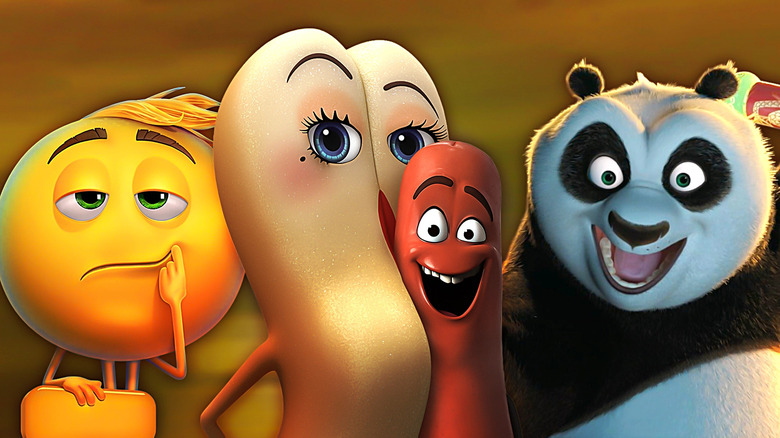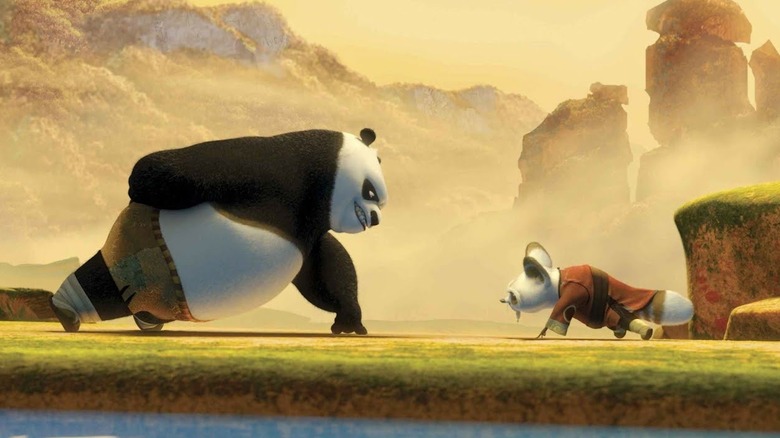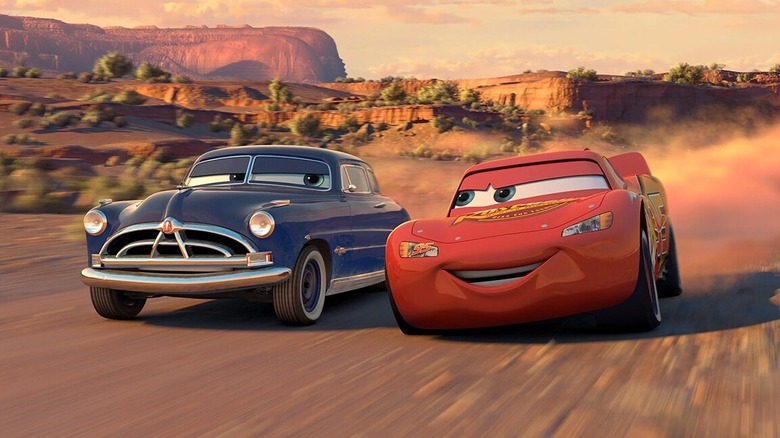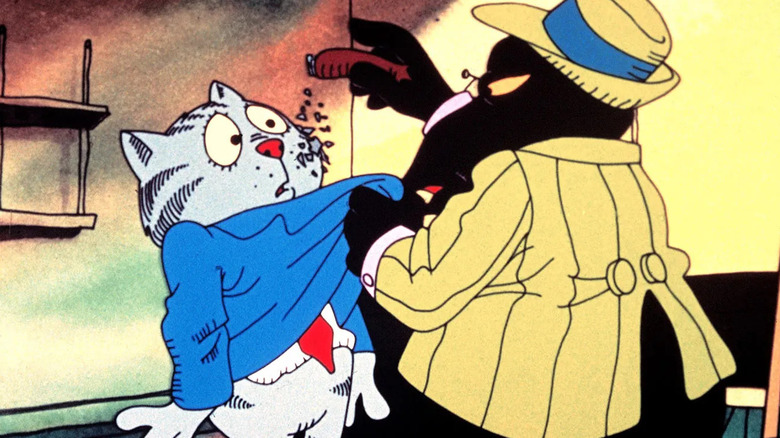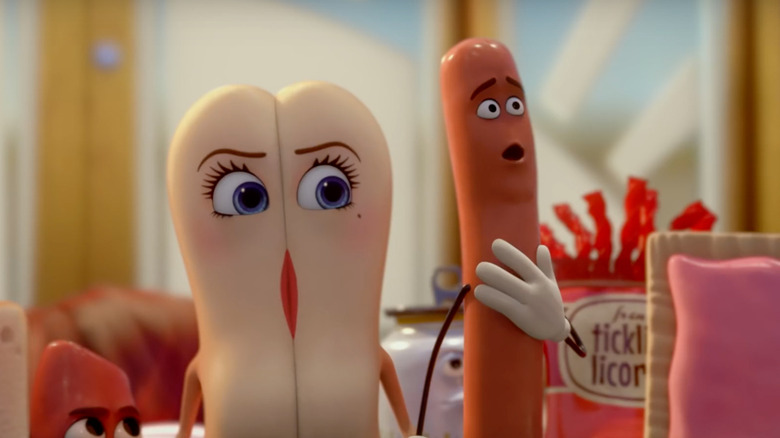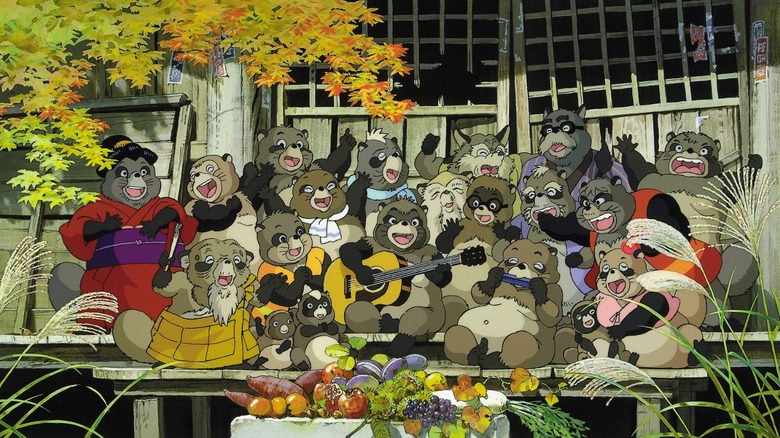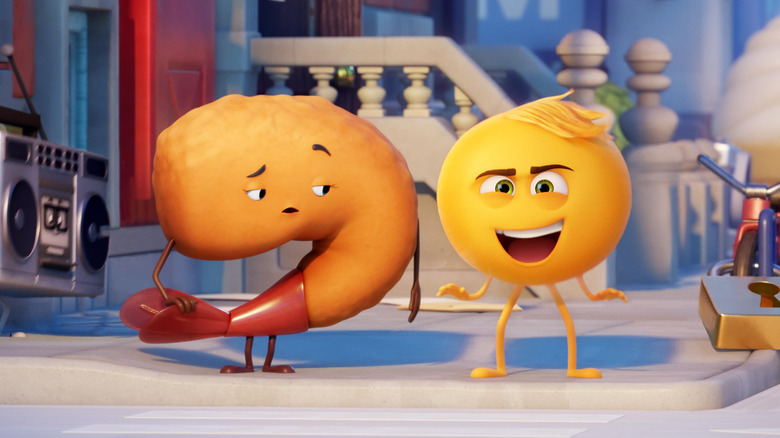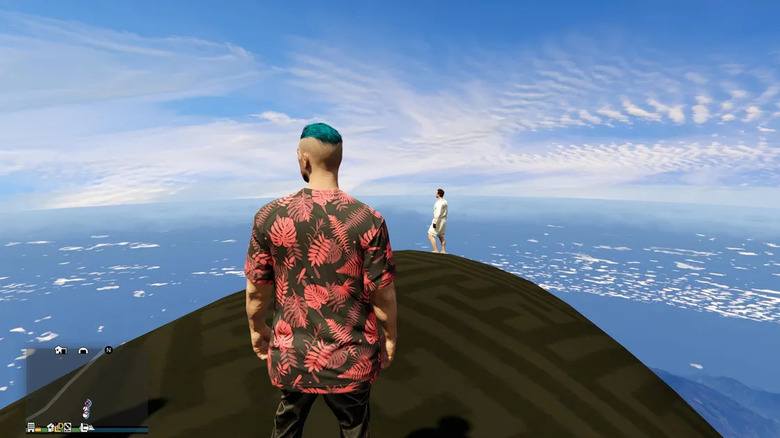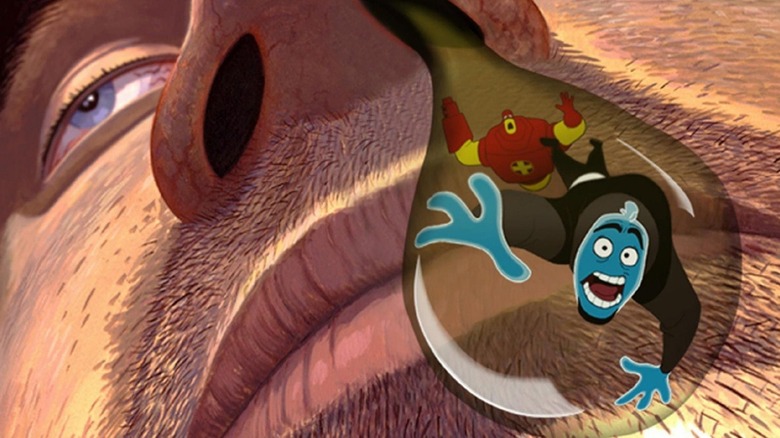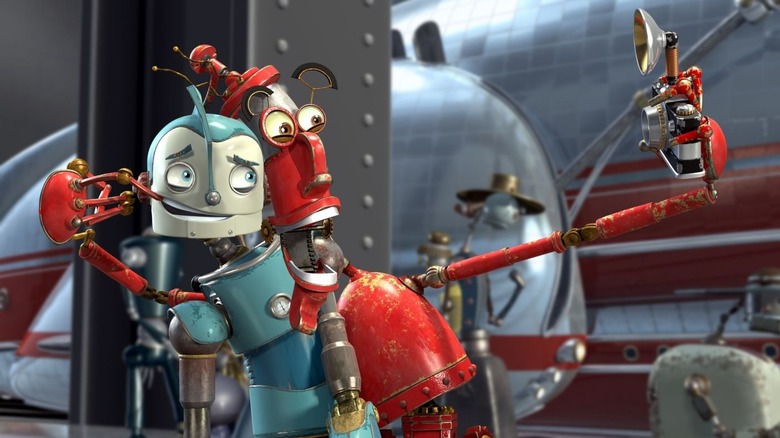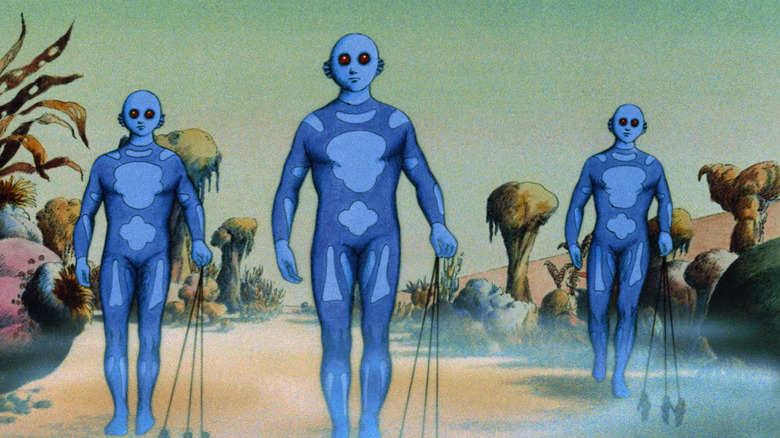10 Animated Movies You Couldn't Make In Live-Action
The mediums of animation and live-action have been swapping stories for decades, from live-action serials for comic strips like "Buck Rogers" and "Dick Tracy" to animated versions of beloved series like "Star Trek" and "Ghostbusters." However, amidst Hollywood's obsession with established intellectual property, we have seen them interact more than ever. Animated anthologies milking the Marvel Cinematic Universe and the dark superhero satire of "The Boys" feel like natural extensions of their brand, while live-action remakes of beloved animated films like "Lilo & Stitch" and "How To Train Your Dragon" have become par for the course, whether people want them or not.
However, not all projects are created equal, and it can often feel like these adaptations are more about keeping copyright alive and less about inspiring quality storytelling. In respect to animation specifically, live-action versions often devalue the essence of what made these stories powerful in the first place, especially when we are blurring the line so much that a "Lion King" remake can claim to inhabit both mediums at once.
Rest assured, animation fans, there are some films that we can confidently say you couldn't make in live-action. Of course, you can never say never in Hollywood, but unless corporate execs want to partake in bestiality, human feces, and rendering photorealistic simulations of our stomach linings, amongst other unique challenges, these 10 animated movies could probably never be made in live-action.
Kung Fu Panda
The live-action Disney remake has run rampant over the last decade, with timeless classics like "Aladdin" and "Beauty and the Beast" being besmirched by hyper-realistic renderings and political course-correcting. Especially egregious are the company's aforementioned hybrid films, such as their remake of "The Lion King" (and, by extension, the film's recently released prequel and slow-burn box office triumph, "Mufasa: The Lion King"), in which every character is animated but only to achieve a live-action look. They managed to make "The Lion King" function in this format — though certainly at a cost — but one has to speculate the limitations. Where do we draw the line between animated animals and a narrative nature documentary?
We will consider multiple examples on this list, but let's begin with a pretty obvious one: Unless DreamWorks wants to animate a photorealistic panda skadoosh-ing his way to glory, "Kung Fu Panda" isn't gonna work. The now long-running franchise's high-flying action and physical slapstick obviously isn't achievable by real, trained animals, at least none we've seen, and any attempts at simulating it are going to look pretty absurd.
Stories like "The Lion King" are ultimately dramas, so, though it stinks to admit it, a more realistic take doesn't break reality if you strip scenes back. With "Kung Fu Panda," its characters are much too squashed and stretched in their kung fu fighting to maintain any sense of realism — and that's perfectly fine! These movies are visually stunning odes to martial arts and don't deserve to be lost in live-action translation.
Cars
The fact that Pixar managed to make animated automobiles work as well as they do across the "Cars" franchise is a testament to both the studio's strength in character design and the power of animation's suspension of disbelief. The eyes are in the windshield, the wheels are their only appendages, and the mouths are basically just pasted on, and Disney doesn't try to get any deeper than that on the confusing world of "Cars."
On paper, all of these ideas are laughable, yet it all works when Pixar works their subtly anthropomorphized magic. "Cars" has become one of Pixar's most iconic brands, spawning sequels, shorts, video games, and theme park attractions, in large part thanks to its lovable case of conceptually bizarre but ultimately charming characters.
If you were to bring these characters into live-action, all of that charm would wear off quickly. Though we've seen live-action car characters, it has mostly been limited to minimal effects work, like with Herbie in "Herbie: Fully Loaded," or glowing dashboards and voiceover, like KITT from "Knight Rider." The physical limitations of actual cars are too much of a hamper on the meaningful character expression and physical comedy exhibited throughout the "Cars" franchise for anything photoreal to work. Needless to say, the uncanny valley would become mountainous.
Furthermore, we already know Disney would cast humans to act alongside the cars in a live-action version, which might make things substantially worse. We don't need to see Lighting McQueen trade quips with Brad Pitt, or have Larry The Cable Guy do a winky cameo with Mater, okay? Let's show some restraint, even though you can actually see an animated car in the hybrid "Chip 'n Dale: Rescue Rangers" movie on Disney+.
Fritz the Cat
For those who have seen "Fritz the Cat," need we say more?
For those unfamiliar, "Fritz the Cat" is well-known for being the first animated film to ever receive an X-rating. Directed by Ralph Bakshi, it takes place in an alternate version of 1970s New York City populated by anthropomorphized animals — think "Zootopia" but way more racist — and follows an aimless feline (Skip Hennant) who drops out of college and goes on a pot-smoking, law-breaking, sex-fuelled odyssey. Yes, that's right. In this film, animals have explicit orgies (yes, penises and vaginas included), smoke copious amounts of marijuana, steal cars, bomb civilians, and a cavalcade of other blasphemous things.
Don't let our astounding description fool you: Aside from some questionable racial profiling, "Fritz the Cat" rocks. It's a deviously satirical and countercultural landmark that paved the way for the adult animation empire that exists today. It is not merely animal porn, as some would have you believe, but instead a "Pippin"-esque commentary on the political institutions that often fail us.
However, do we want to see any of that portrayed with real animals? No! Not at all! That's just gross, not to mention a few degrees away from illegal. It would be an admirably audacious experiment, not to mention piss off all the right people, but the results would simply be too off-putting. I mean, the last time we got live-action cats was...well, 2019's "Cats." We saw photorealistic cat buttholes, and we don't need to see them again.
Sausage Party
"Sausage Party" may not have as much sex and drugs as something like "Fritz the Cat," but any sex in a movie about literal hot dogs, tacos, buns, and bagels is immediately a pretty strong disqualifier for a live-action remake. We're all for food porn, but not food porn, ya know?
Anyone who knows about the intercuisinal orgy that caps off the climax (pun so, so intentional) of "Sausage Party" should know that Conrad Vernon & Greg Tiernan's crass culinary comedy would be a pretty wild film to adapt into live-action. Sure, all of the items in the film are tangible, so it wouldn't be difficult to recreate and manipulate them using visual effects. At the same time, there are just some acts we don't need to see committed by food on screen, technical wizardy be damned. Our motley crew of household grocery items sing musical numbers, drug and kill civilians, and experience gruesome deaths. Why in the world would we want to recreate all of that with an aesthetic that would essentially amount to The Annoying Orange with a bigger budget?
Say what you will about "Sausage Party," a franchise made exclusively for sickos, but at least it proves the singular power of its medium. This movie could never exist in live-action because it is a product so grotesque in its current form that we don't need to look photorealistic.
Pom Poko
We couldn't go through this entire list without mentioning at least one anime. After all, how many times have we seen a brilliant Japanese masterpiece besmirched by a cash grab? There are countless anime films we could select for this list, but it feels especially powerful to select a work from Studio Ghibli, whose aesthetic has recently been co-opted by artificial intelligence.
Keeping in line with our animal theme, let's talk "Pom Poko." This wondrously imaginative adventure from Isao Takahata, the often under-appreciated half of the Studio Ghibli dream team, focuses on a colony of tanuki, or raccoon dogs, who are forced to relearn their long-dormant shapeshifting skills when land developers begin to destroy their forest home. Though it begins cute and cuddly, its ambitions grow dramatically as its characters take on more and more elaborate disguises. It grows to the point that any kind of live-action rendering would turn the film's surreal charm into full blown horror, especially as one particularly climactic sequence sees the characters transform into several different things in one final "grand illusion" to raise public awareness of their plight, and that includes several demons and even a giant skeleton.
If that wasn't enough, several of the film's most popular Letterboxd reviews will cite the film's abundant use of raccoon testicles, which engorge in size as a tool in tanuki combat. If you're still considering a live-action film after learning that detail, you probably shouldn't be making movies in the first place.
The Emoji Movie
What exactly do live-action emojis look like? This would be the conundrum facing a flesh and bone take on "The Emoji Movie," a film that was already pretty lifeless to begin with. Nobody ought to waste time duplicating this corporate sellout of a movie for any reason, but for the purposes of this thought exercise, let's consider the nightmare fuel that may await us.
In fairness, parts of the movie take place in a human world, so that would be portrayed by merely human actors. Plus, plenty of emojis are just regular things from our everyday lives but smaller, so that wouldn't be hard to replicate. However, what do we do about ol' Gene Meh (T.J. Miller) and the rest of the humanoid characters? Hell, what do we do about weird hybrids like Hi-5 (James Corden) or Poop (Patrick Stewart)? Are we to give human eyes and a human mouth to a photoreal human hand, or — heaven forbid — human eyes, human eyebrows, and a real bowtie on a sentient piece of feces? And this isn't even accounting for their weirdly proportioned bodies!
The closest example to a "live-action emoji" we can think of is M.O.D.O.K. (Corey Stoll) from "Ant-Man and The Wasp: Quantumania," with his stretched out face and tiny appendages, and that looked absolutely terrible (but we also kinda loved it too). As much as we would love to see another multi-billion dollar conglomerate waste their blood money on an absolute night terror, it isn't worth the eyesore.
Grand Theft Hamlet
This is a weird inclusion, but level with me here. "Grand Theft Hamlet" is a very unique animated movie, a documentary about a group of amateur thespians who, amidst the COVID-19 pandemic, decide to stage a production of William Shakespeare's "Hamlet" within the world of "Grand Theft Auto Online." Captured entirely using in-game footage, it is technically an animated film, even if the filmmakers aren't fully responsible for the animation itself. Regardless, the animation plays a pivotal role in the conceit of the documentary. If you were to try and conceive the movie in live-action, the whole thing falls apart.
Part of the documentary's appeal is that it puts the violent antics of GTA in juxtaposition to the gravitas of "Hamlet." Watching folks rehearse Shakespeare within the same world where you can commit hit-and-runs and shoot flamethrowers is hilarious, yet it shows you that even the strangest modes of connection can be endearing and powerful. You never see any real people speaking while they're in-game, nor do the game's character models ever mouth a single word. There is a very distinct aesthetic disconnect going on, an alchemy which simply wouldn't work if there were real humans controlling real human avatars. We've seen versions of that, like the recent "Jumanji" reboots, or even hybrids of live-action and animation like "Ready Player One," but those are entirely different beasts. "Grand Theft Hamlet" is singular in its construction and will likely stay that way.
Osmosis Jones
"Wait," I hear you cry, "doesn't this movie already have live-action scenes?" Yes, dear reader, it does, but hang on a second. Sure, the Bill Murray-led scenes in "Osmosis Jones" show that part of the movie's conception is based in the medium of live-action. In fact, it's a clever part of the film's construction, which is why making both halves live-action (or at least making the animated side look more photorealistic) would spoil the fun. The whole point is that the animation juxtaposes the real actors. Why ruin that?
Besides, making a movie about the human body entirely in live-action would require an amount of visual effects so extensive and expensive that it would make James Cameron's head spin, not to mention it would look pretty gnarly. We get very brief glimpses of CGI-animated veins and gums and other bodily functions during transitions in and out of Frank, and needless to say, it's not something that our eyes could sustain looking at for a 90-minute runtime. Sure, effects have improved since 2001, but not to the point where it could make photoreal renderings of the human body palatable for a narrative story.
Speaking of which, imagine characters like Osmosis Jones (Chris Rock) and Thrax (Laurence Fishburne) rendered as actual cells and bacteria. Have you seen microscopic pictures of these things? They're bulbous, wriggly, and not at all conducive to character expression. The original film had hilarious character designs that brought clever life to its buddy cop pastiche. You take that away, and all you're left with is a video for your health class.
Robots
We're all so preoccupied with whether or not AI is going to replace actors and cameramen, but what about robots? If advancements in the industry tell us anything, androids are becoming more and more human by the hour. If we're so worried about machines taking over the world, wouldn't that mean they would also take over Hollywood? Would that also mean that, given Hollywood's inevitable plan to attempt adapting every animated film into live-action, that there's a possible world in which a live-action version of "Robots" (RIP Blue Sky Studios) would be acted by actual robots?
Well, if that world does exist, it ain't happening anytime soon. Even judging by the most recent examples of AI-driven humanoid robots, the uncanny valley reigns supreme. The realistic facial expressions and body movements just don't feel quite right, and that's them trying to recreate a normal human. Imagine them trying to simulate the janky, stretchy, and wonderfully scrappy models in the film, complete with well-oiled physical humor and more than one set of bizarre bodily proportions. Sure, the characters look like they were built from sheet metal and springs and other odds and ends you could find in a junkyard somewhere, suggesting real-life versions are feasible. However, animation is image plus motion. Without the anima in animation (the Latin root roughly translated to "soul"), there's no life. If there's no life, even in a movie about machines, your movie is toast.
Fantastic Planet
The difficulties in transition between animation and live-action are a global struggle. If you thought American animation was occasionally weird, you may not be ready for some of the international animation available out there, let alone what it might look like if it were to go beyond two dimensions. Case in point: "Fantastic Planet" is one of the trippiest films ever made, animated or otherwise, filled to the brim with strange alien creatures and colorful but cavernous landscapes. Any attempt at trying to smooth over its clearly surrealist imagery would produce images ranging from pretty silly to just plain terrifying.
For example, the film is set on a planet run by an advanced alien species named the Draags who rule over humans — here named Oms — like animals, "Planet of the Apes" style. Some may see these Draags, who did the whole "blue alien" thing before James Cameron made it cool with "Avatar," and think, "Oh, so humans could play these guys!" They have eyes, ears, and a mouth, so what's holding us back? These are probably the same people who thought that animated "Star Wars" characters like Cad Bane and Grand Inquisitor would look swell in live-action, and look where that got us. The Draags would look hideous in real-life, with their blank, red eyes and nonchalantly exposed breasts. Plus, they'd have to be significantly bigger than us, making for a rendezvous into "Gulliver's Travels" territory that we really don't need to repeat.
